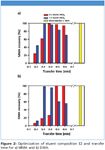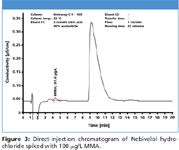Trace-Level Aliphatic Amines in Cationic Drugs
The analytical challenge treated in the present work consists in determining sub-ppb concentrations of low-molecular-weight amines in the presence of strongly retained cationic drugs by using ion chromatography (IC) with upstream inline coupled-column matrix elimination (CCME).
The analytical challenge treated in the present work consists in determining sub-ppb concentrations of low-molecular-weight amines in the presence of strongly retained cationic drugs by using ion chromatography (IC) with upstream inline coupled-column matrix elimination (CCME). In contrast to direct-injection IC, where the late elution of strongly retained drugs is a significant drawback and requires eluents with added acetonitrile, the low-pressure CCME technique — by using two preconcentration columns in series — gets by without solvent-containing eluents. In an "inverse matrix elimination" step, cationic drug and target amines are trapped on a high-capacity and a very-high-capacity preconcentration column, respectively. During the separation step, a rinsing solution flushes the drug retained on the high-capacity preconcentration column to waste. Application of CCME significantly shortens the analysis time, protects the analytical column, and improves sensitivity, as well as selectivity.
Besides the determination of monomethylamine in Nebivolol hydrochloride discussed here, the CCME technique is a promising tool for determining further low-molecular-weight amines in a wide range of drugs.
Low-molecular-weight amines find widespread use in raw materials or intermediate products, in the manufacturing of numerous chemicals, pharmaceuticals, polymers, pesticides, rubber, dyes, adhesives, solvents, and corrosion inhibitors. Their monitoring is crucial as most of them are toxic. Their determination, however, is a challenging task because the protonated amines are often poorly retained on the column, which results in very short retention times, poor separation, and strongly asymmetric peaks. Separations become even more demanding in the presence of interfering cationic drug ingredients.
These shortcomings can be overcome by applying coupled-column matrix elimination (CCME). After optimization of the CCME parameters, trace levels of monomethylamine (MMA) are determined in the cationic beta blocker Nebivolol hydrochloride. Alternatively, direct injection results are presented.
Experimental
Instrumentation
Upstream matrix elimination uses a high-capacity (Metrosep C PCC 1 HC) and a very-high-capacity preconcentration column (Metrosep C PCC 1 VHC) in series. Three peristaltic pumps PP (Figure 1) take over the complete sample transfer steps within the CCME.
All determinations were performed on the 850 Professional IC – Cation – Prep 2. Chromatographic conditions are indicated in the respective chromatograms. All columns and instruments are from Metrohm.
Amine standards, drug samples, and eluents
All reagents used in this work were of the highest purity grade (puriss. p.a.). Eluents were prepared with deionized water having a specific resistance higher than 18 MΩ cm. While suprapure nitric and hydrochloric acid for eluent preparation were obtained from Merck Germany, analytical grade acetonitrile was purchased from Merck India. Amines or their respective hydrochloride salts were purchased from Sigma-Aldrich Switzerland (Fluka brand). Nebivolol hydrochloride samples originated from Heterolab (Hyderabad, India).
Results and discussion
Coupled-column matrix elimination
a) The sample is transferred to the Metrosep C PCC 1 HC high-capacity preconcentration column, which traps the amines and the cationic drug (Figure 1a). Sample transfer occurs by a peristaltic pump using ultra-pure water that was previously freed of trace cations by passing through a high-capacity trap column.
b) While the cationic drug is retained on the Metrosep C PCC 1 HC, amines are selectively eluted with eluent E2 and subsequently trapped on the Metrosep C PCC 1 VHC very-high-capacity preconcentration column (Figure 1b). The optimization of eluent composition E2 and corresponding transfer time is described in the next chapter.
c) The trapped amines are eluted with eluent E1 and transferred to the separation column (Figure 1c). Simultaneously, the rinsing solution R1, having a high organic modifier content, flushes the drug from the cation-retaining Metrosep C PCC 1 HC to waste. The Metrosep C PCC 1 HC preconcentration column is now ready for the next sample.

Figure 1
Optimization of eluent composition E2 and transfer time
By means of the early-eluting monomethylamine (MMA) and dimethylamine (DMA), eluent composition E2 and the corresponding transfer time (flow rate = 0.47 mL/min) were optimized in terms of amine recovery. The latter was calculated by comparing the peak area obtained after matrix elimination with the peak area after direct injection onto the C PCC 1 VHC preconcentration column. According to Figure 2, best results for MMA and DMA determination were obtained for 1.0 mmol/L nitric acid as eluent E2 and a transfer time of 0.35 min.

Figure 2
MMA in Nebivolol hydrochloride
By means of MMA determination in Nebivolol hydrochloride – an exemplary cationic drug and cardioselective beta blocker with pronounced antihypertensive effect – the performance of the common direct-injection procedure and of the previously described CCME are illustrated.

Figure 3
a) Direct injection
Acetonitrile additions to the eluent reduce the strong lipophilic interactions of the cationic pharmaceutical with the column's carrier material and thus shorten the drug's retention time. However, such organic solvent additions impair detection sensitivity and selectivity. While direct injection is still feasible for MMA determination in Nebivolol hydrochloride (Figure 3), monitoring of higher amine homologues in strongly retained cationic drugs becomes increasingly difficult.

Figure 4
b) CCME
CCME allows for a rapid determination of trace-level MMA with recoveries ranging between 101 and 106% (Table I). Relative standard deviations (RSDs) are better than 5%. The method excels by its capability to simultaneously determine various low-molecular-weight amines in strongly retained cationic drugs.

Table I: MMA recoveries in Nebivolol hydrochloride samples
References
(1) N. Harihara Subramanian, "Development of novel methods for the determination of trace ionic contaminants in complex matrices using ion chromatography," Ph.D thesis, University of Madras, Chennai, India, in preparation (2009).
(2) Metrohm Application Notes AN-C-007, AN-C-052, AN-C-057, AN-C-070; AN-C-078, AN-C-092...AN-C-093 and AN-C-124...AN-C-126 (downloadable under http://products.metrohm.com).

Metrohm International Headquarters
CH-9101 Herisau, Switzerland
tel. +41 71 353 85 04
Email: aw@metrohm.com;
Website: www.metrohm.com

SEC-MALS of Antibody Therapeutics—A Robust Method for In-Depth Sample Characterization
June 1st 2022Monoclonal antibodies (mAbs) are effective therapeutics for cancers, auto-immune diseases, viral infections, and other diseases. Recent developments in antibody therapeutics aim to add more specific binding regions (bi- and multi-specificity) to increase their effectiveness and/or to downsize the molecule to the specific binding regions (for example, scFv or Fab fragment) to achieve better penetration of the tissue. As the molecule gets more complex, the possible high and low molecular weight (H/LMW) impurities become more complex, too. In order to accurately analyze the various species, more advanced detection than ultraviolet (UV) is required to characterize a mAb sample.















